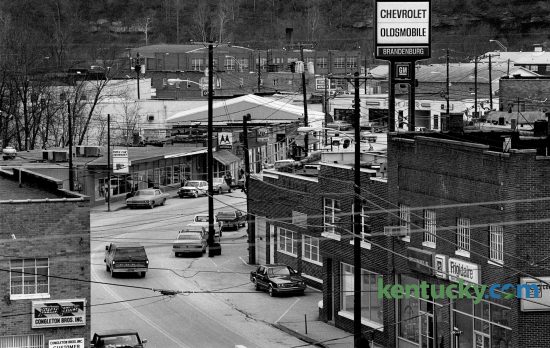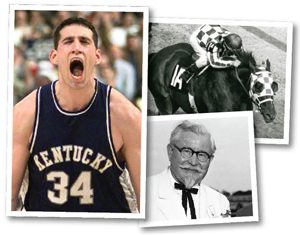October 16, 2025
Kentucky Derby infield, 1983
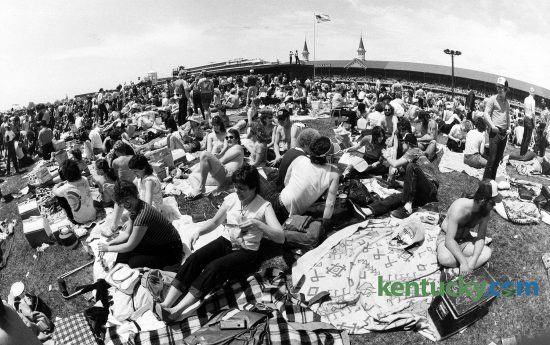
The crowd in the infield at Churchill Downs on Derby Day, May 7, 1983. Many of the 85,000 in attendance were spread out across the 144 acres of the infield, and the crowd was described by Kentucky Derby regulars as one of the raunchiest in memory. Across the grounds, women found themselves instant celebrities as they lifted their shirts to the cheers of many around them. Photo by Charles Bertram | Staff
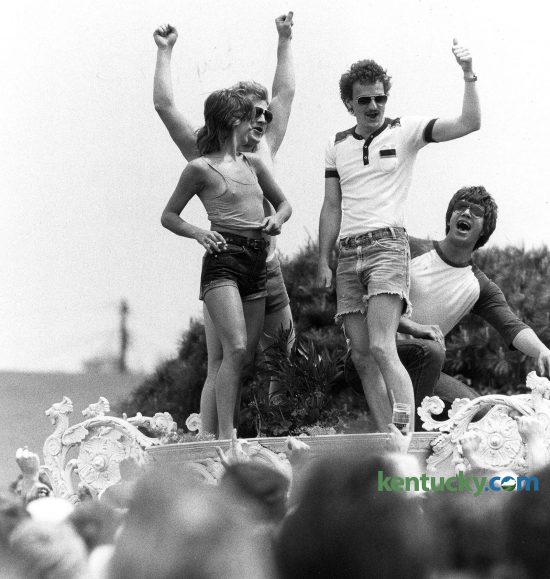
Infield revelers climbed up on a huge white garden urn and encouraged a woman to strip. Photo by Charles Bertram | Staff
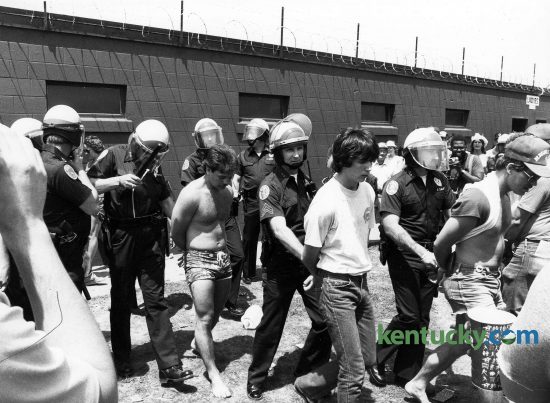
Louisville police officers detained some Kentucky Derby infield patrons on May 7, 1983, at Churchill Downs. Many were taken to a holding cell nearby. Photo by Charles Bertram | Staff
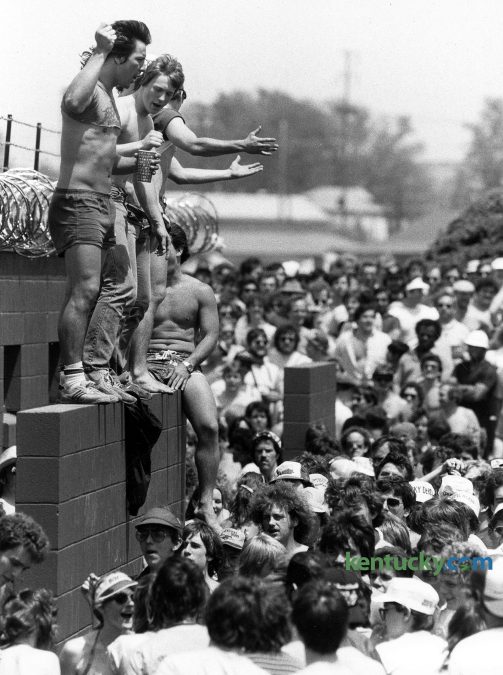
Despite the threat of barbed wire fence, infield patrons climbed up the outside of a restroom entrance on May 7, 1983, at Churchill Downs. Not more than 100 yards away were several dense clumps of bushes that served as alternate restroom space as the afternoon wore on. Photo by Charles Bertram | Staff
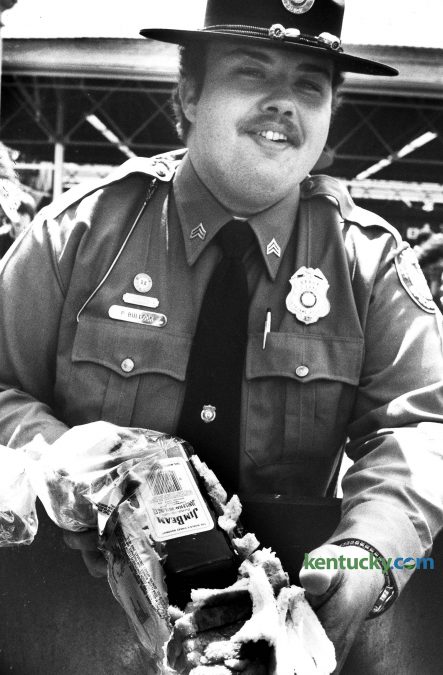
Officer Paul Bullock confiscated whiskey in loaves of bread. Guards at the gates tried to take any alcohol, but of course, much made its way in. One Louisville man poured vodka into plastic zip-lock bags, then hid them beneath a salad in a Tupperware bowl. He made it successfully past the gate. Photo by Christy Porter | Staff
Rapper M.C. Hammer’s horse runs in the Kentucky Derby, 1992
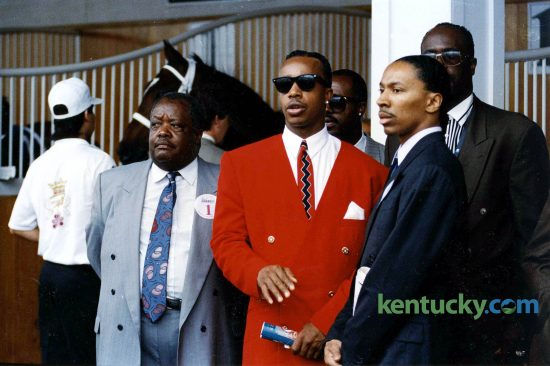
Rapper M.C. Hammer, center, surrounded by family in the Churchill Downs paddock just before the Kentucky Derby, May 2, 1992. In the background is Hammer’s horse, Dance Floor, who finished third in the Run for the Roses. Hammer rose to fame in 1990 with his song U Can’t Touch This. Click here to see a gallery of celebrities attending the Kentucky Derby from years past. Photo by Charles Bertram | Staff
Donald Trump and Melania Knauss at the Kentucky Derby, 1999
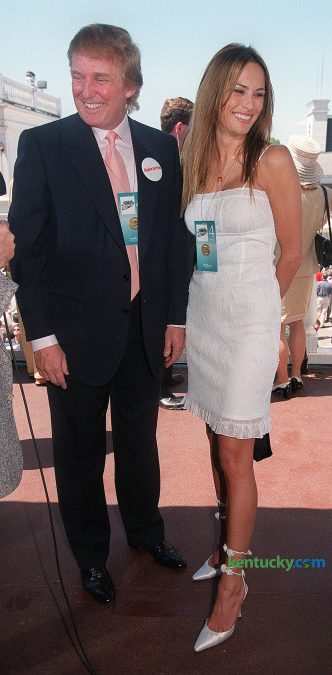
Businessman Donald Trump and his then-girlfriend, Melania Knauss, at the 125th running of the Kentucky Derby on May 1, 1999. At the time of the photo, the couple had been dating about a year. They would get married in 2005. Currently, Trump is the presumptive Republican nominee for U.S. president. Click here to see a gallery of celebrities attending the Kentucky Derby from years past. Photo by David Stephenson | Staff
Kentucky Derby draw, 1988
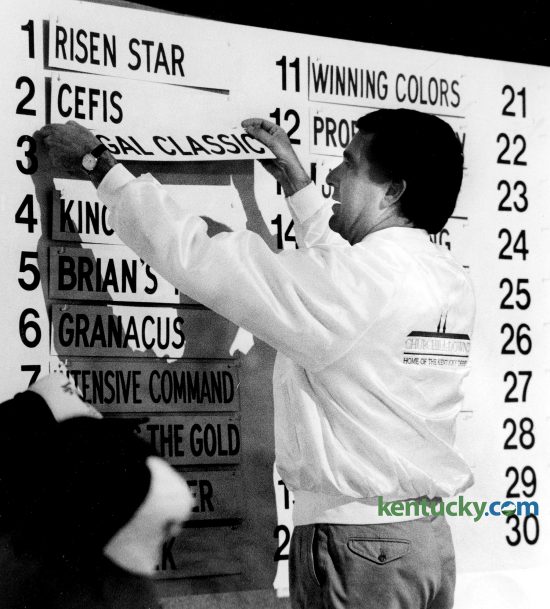
Louisville Mayor Jerry Abramson put up the last name drawn for the 1988 Kentucky Derby, Regal Classic in post position No. 3, on May 5, 1988, in Louisville. Seventeen 3-year-olds were entered in the 114th running of the Derby, with the winner taking home $611,200 of the $786,200 purse. By comparison, the 2016 purse is $2 million, with $1.24 million going to the winner. Trainer D. Wayne Lukas’ Winning Colors drew an ideal spot in the No. 11 position in the gate and ended up winning the Run for the Roses two days later. She was the only filly in the race. The draw for the 2016 race is Wednesday, May 4. Photo by Ron Garrison | Staff
Downtown Beattyville, 1987
Bear-wrestling at Fayette Mall, 1980
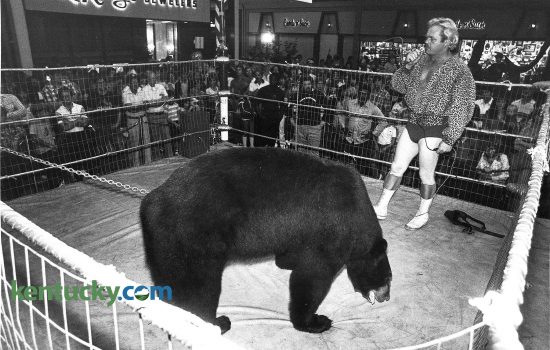
Victor the wrestling bear took on all comers during Fayette Mall’s ninth anniversary celebration on Sept. 24, 1980. Victor was declawed and defanged, and he was muzzled when he wrestled. He reportedly stood 6 feet, 9 inches tall and weighed about 650 pounds, although those numbers varied, according to this story. Anyone older than 18 could wrestle Victor. Photo by Ron Garrison | Staff
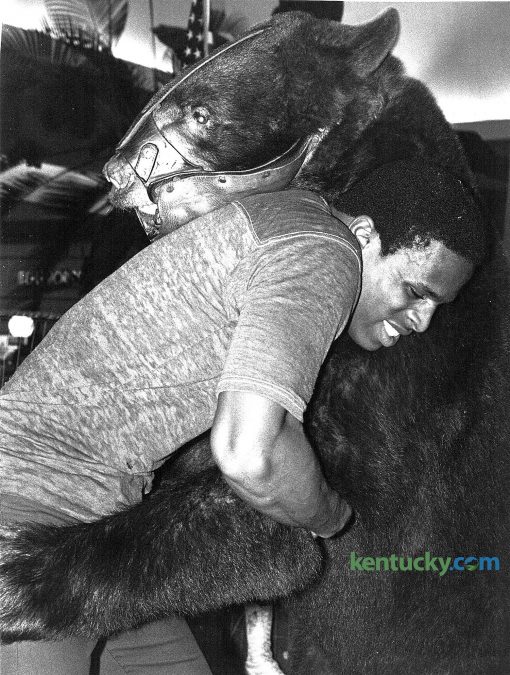
University of Kentucky wrestler Fred Ringo accepted the challenge and took on Victor the traveling wrestling bear at Fayette Mall on Sept. 24, 1980, as part of the mall’s ninth anniversary celebration. Victor stood 6 feet, 9 inches tall and weighed about 650 pounds. Anyone older than 18 could wrestle Victor. Photo by Ron Garrison | Staff
Nazi war dog comes home with G.I., 1946
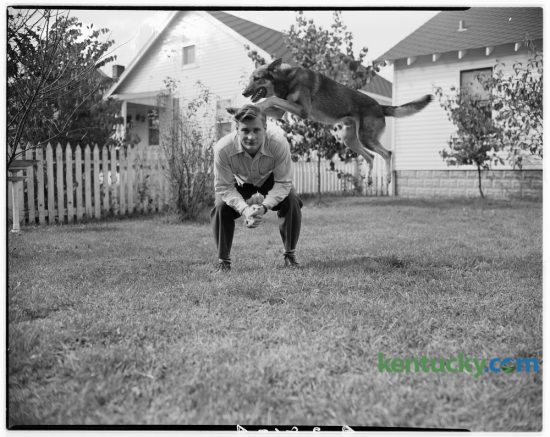
U.S. Army Sgt. James Hellard, who returned from Germany on Aug. 31, 1946, posed for an action photo with his adopted Nazi-trained war dog, Tiger, at his home in Lexington. Tiger, a 90-pound police dog, was captured in May 1945 near Camp Dachau by a soldier in Hellard’s company. Taken from an SS captain, he was brought back to the camp to be a mascot. When first brought to camp, he exhibited a hatred for G.I.’s by biting them, thus earning the name Tiger. After some retraining by Hellard, he gradually lost his intense dislike for Americans. Published in the Lexington Herald on Oct. 2, 1946. Herald-Leader Archive Photo
Kentucky Guard Ed Davender, 1984
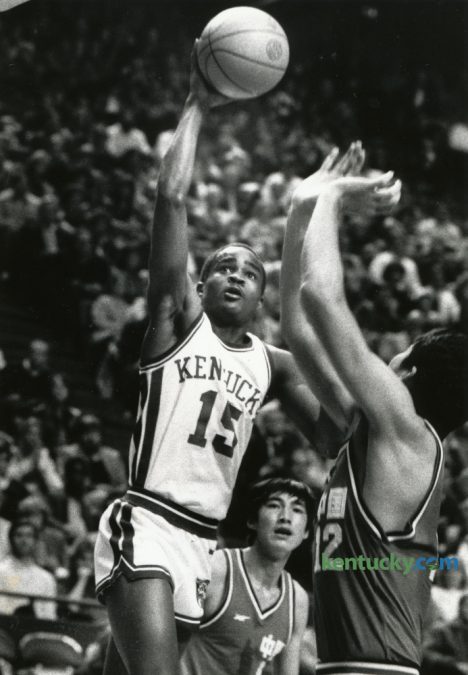
University of Kentucky basketball player Ed Davender, put up a shot in an exhibition game November 11, 1984 in Rupp Arena. Considered one of the most under-appreciated guards in UK basketball history, died late Thursday night after suffering a massive heart attack on Tuesday. He was 49. Photo by David Perry | Staff
UK baseball light tower, 1987
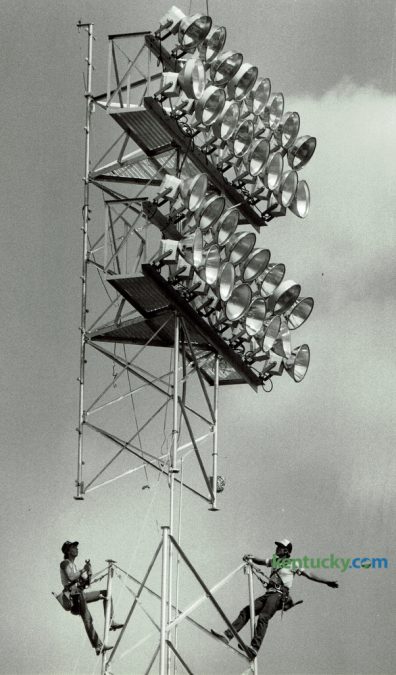
Workers Shane Sowards, left, and Mike Powell, both from Fort Wayne, Ind., prepared to attach a bank of lights to one of six newly installed lighting towers at the University of Kentucky’s baseball field at the Shively sports complex on Sept. 14, 1987. The lights, a $200,000 project, were in place in time for the team’s opening game Sept. 19. The six new towers contained a total of 180 lights. Photo by Frank Anderson | Staff
Morehead State basketball coach Dick Fick, 1993
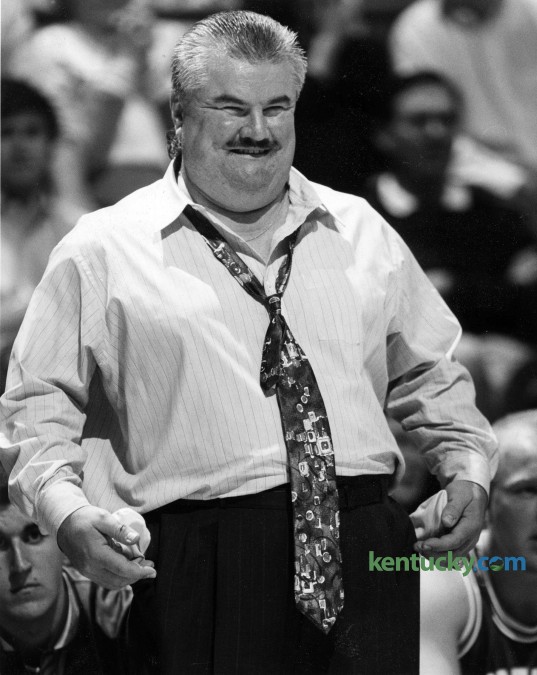
Morehead State basketball coach Dick Fick reacted to an official’s call during the Eagles’ 97-61 loss to Kentucky at Rupp Arena on Dec. 17, 1993. The flamboyant coach led the Eagles for six rollicking years (1991-97) and compiled a 64-101 record. He was so well-known for his sideline antics that the late Jim Valvano of ESPN handed out the “Dick Fick Award,” which went weekly to the coach who showed the most sideline animation. Once, in a game in Cincinnati, Fick held up a three-point sign to the UC student body every time Morehead made a three-pointer. His most famous moment came in 1992, in a game against Kentucky in Rupp Arena. MSU was victimized by an over-the-back call. In response, Fick collapsed flat on his back, his arms elevated straight up in disgust. But Fick could be every bit as clever as he was ebullient. One summer, he picked up a newspaper and saw that University of Cincinnati center Art Long had been arrested for punching a police horse. He was immediately on the phone to Bearcats Coach Bob Huggins. “Bob, I can help you,” Fick said. “I know there is no way Art Long punched that horse.” Huggins: “How?” Fick: “He’s still in the lane from when we played you last year.” In 1997, Morehead refused to extend Fick’s contract, and in 1999, he publicly admitted that he was an alcoholic after he was in and out of alcohol treatment programs. He wound up back in his hometown, Joliet, Ill., as a part-time assistant coach at University of St. Francis, an NAIA school. On April 28, 2003, Fick, 50, was found dead in the Joliet apartment where he lived by himself. Photo by Frank Anderson | Staff

